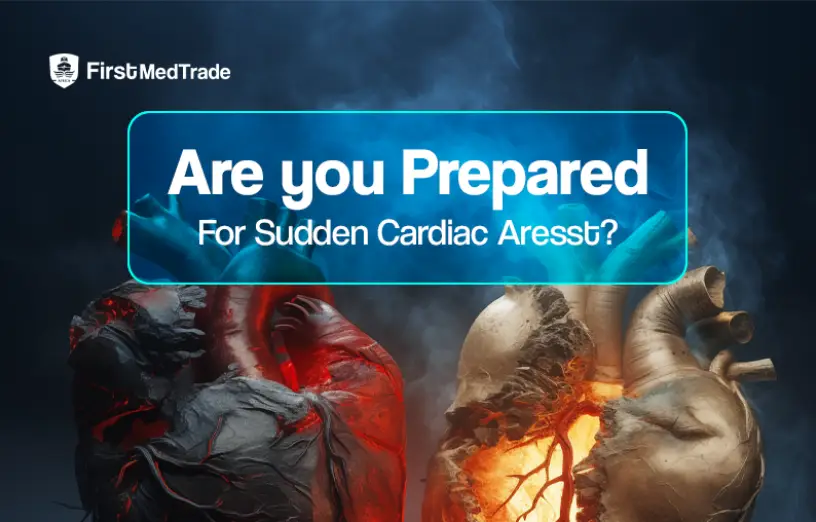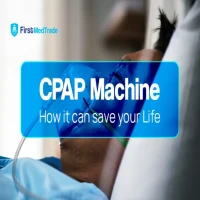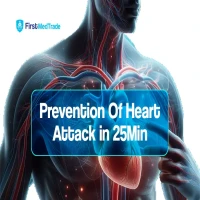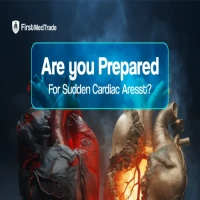Are you prepared for sudden cardiac arrest?
Did you know?
Heart attacks are not the same as cardiac arrest–they are different! A heart attack is a “plumbing problem” that occurs when the blood flow to the heart muscle is blocked, while a cardiac arrest is an electrical problem. Cardiac arrest occurs when the heart's electrical system malfunctions and the heart beats rapidly and
randomly or stops beating completely. A heart attack leads to cardiac arrest.
During daily activities and leisure activities such as cycling, skiing, and regular work, you may experience shortness of breath, chest discomfort, palpitation,
weakness, and loss of consciousness. When these signs appear, don't take them for granted. Cardiac arrest happens in an instant!
What causes cardiac arrest?
At each heartbeat, blood is pumped throughout the body, carrying oxygen and nutrients to all cells. The heart's natural electrical system keeps the heart beating in a regular rhythm, but the electrical signals that flow through the heart may not "communicate" properly with the heart muscle. This makes the heart beat in an abnormal pattern. This is a condition known as arrhythmia. Arrhythmias can cause the heart to beat too fast or too slow. It can even cause the heart to stop
pumping blood around the body. When this happens, it is called cardiac arrest.
- Cardiac arrest may be a result of
- Coronary heart disease
- Dissecting Aortic Aneurysm
- Heart attack
- Enlarged heart
- Electric issues within the heart
- Electric shock
- Usage of positive unlawful drugs
- Damage to the heart at the wrong moment of the heart's cycle
Symptoms of Cardiac Arrest
Immediately before cardiac arrest, some people may feel tired, have chest pain, shortness of breath, fainting, or vomiting. Cardiac arrest often occurs without
warning. During cardiac arrest, parts of the body, including the brain, do not receive the oxygen they need and can quickly become damaged. This can become
fatal within minutes!
When a cardiac arrest happens, a medical emergency that requires immediate treatment with a device called a defibrillator is urgently needed.
AEDs — What are these?
Automatic External Defibrillators (AEDs) are portable life-saving devices used to treat people with sudden cardiac arrest. They work by giving an electric shock
to get the heartbeat started again.
The combination of cardiopulmonary resuscitation (CPR) and early defibrillation can be life-saving when used in the first few minutes after sudden cardiac
arrest.
The AED system contains accessories such as batteries and pad electrodes that the AED needs to detect, interpret the electrocardiogram, and deliver an
electric shock.
TYPES OF AEDs
There are two main types of AEDs: public access and professional use.
Public access AEDs can be located at airports, community centers, schools, government buildings, hospitals, offices, and other public places. These are
intended for use by minimally trained laymen.
Professional use AEDs are used by first responders, such as emergency medical technicians (EMTs) and paramedics, who receive additional AED training.
The AED can be semi-automatic or fully automatic.
The Semi-automatic defibrillator analyzes the heart rhythm, and if an abnormal heart rhythm that requires shock is detected, the device prompts the user to
press a button to give a defibrillation shock.
A Fully automated defibrillator analyzes the rhythm of the heart and provides defibrillation shocks at the command of device software without user
intervention.
HOW TO ADMINISTER CPR AND DEFIBRILLATOR IN AN EMERGENCY
- Call emergency medical help or services. If you’ve got instant access to a telephone, call before beginning CPR.
- Perform CPR. Quickly check the person's respiration. If the person isn't breathing normally, start CPR. Push hard and fast on the person's chest — at the rate of 100 to 120 compressions a minute.
If you are CPR trained, check the person’s airway and give a rescue breath after every 30 compressions. If you are not trained, continue chest compressions.
Wait for the chest to rise completely during the compressions. Continue this until a portable defibrillator becomes available or emergency service arrives.
- Use a portable defibrillator, if available. It gives you step-by-step voice instructions. Continue chest compressions while the defibrillator is charging.
Once charged, the defibrillator checks the rhythm of the person’s heart and recommends a shock if necessary. If the device recommends, shock and then
resume CPR immediately. Start with chest compressions or do only chest compressions for about 2 minutes.
Use a defibrillator to check the rhythm of a person's heart. If necessary, the defibrillator gives another shock. Repeat this cycle until the person regains
consciousness or the emergency response personnel take over.
Portable automated external defibrillators (AEDs) can be used in many locations, including airports, private and government offices, schools, casinos, and
shopping malls. You can also buy it for your home. The AED has a built-in instruction manual. They are programmed to shock only when appropriate.
Note: Based on how the defibrillator works, you need to make sure that the AED is FDA-approved or approved by the appropriate national regulatory agency in
your country. Why is it important? These regulators are responsible for protecting and promoting general public health through the control and supervision of
medical devices and equipment.
Recommendations for healthy living
1) Do a yearly whole body check especially cardiovascular assessment once above 40 years.
2) Postnatal cardiovascular evaluation for all children is advised.
3) Biochemical metabolic assessment is encouraged for pre and postnatal to correct pending metabolic errors.
4) Healthy lifestyle modifications with exercise.
5) Avoid Smoking and all other illicit activities.







